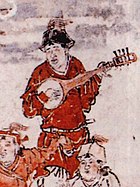Tungna (original) (raw)
From Wikipedia, the free encyclopedia
Nepali Folk instrument
Tungana
 Tungana or Tungna Tungana or Tungna |
|
|---|---|
| Other names | Tungna sgra-snyan (Tibet)[1] |
| Classification | String instrument (plucked) |
| Hornbostel–Sachs classification | 321.322 (necked box lute)(Chordophone) |
| Developed | Nepal and Bhutan |
| Related instruments | |
| Arbajo Dotara Dranyen Kabuli rubab Pamiri rubab Sarod Seni rebab |
The Tungna (Nepali: टुङ्ना) is a plucked string instrument from the Northern Himalayan region: Nepal, Tibet, Sikkim and Bhutan.[1] It is made from a single piece of carved wood. The front hollow body (which serves as the sound-box) is covered with stretched animal skin on which the 'bridge' sits.[2] The Tungna has four strings which is anchored to the keys and body at both ends and the 'bridge' acts as a cantilever thus maintaining the tension of the strings.
It is mostly played by the people in the Himalayan Kingdom of Nepal mainly by the Tamang, Gurung and Sherpa people during auspicious occasions, gatherings and festivals. The musicians play the Tungna and sing songs, which they compose themselves especially to welcome the New Year or during the harvest season. Most households of this mountain region have at least one Tungna in their house.
Iranian style rubab from the 13th century C.E., found in Rayy (near Tehran, Iran).
Mongolian lute, circa 1297, Tomb of Wang Qing, China
- ^ a b "Images from The Beede Gallery Lute (Tungna), Nepal, 19th Century".
- ^ Nagendra Śarmā (1992). Secrets of Shangri-La: an enquiry into the lore, legend and culture of Nepal. Nirala Publications. p. 51. Retrieved 24 March 2012.
- Kutumba Instruments
- Tungana at Atlas of Plucked String Instruments
- Art tribal de l'Himalaya at Sanza.Skynetblogs.be (in French)

